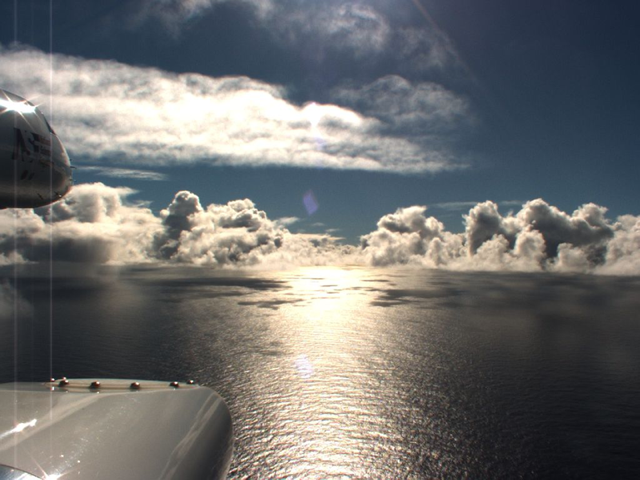Cloud Drops Stick Together
Turbulent flows are excellent at mixing fluids over a wide range of length scales. But there are scenarios where turbulence fails to mix a system. For example, if the fluid contains particles of a higher density, turbulent flow can cause particle clustering, where the particles “unmix” from the fluid and clump together. Scientists postulate that turbulence-induced particle clustering occurs in clouds, pushing raindrops together and increasing the chance that two drops will collide and coalesce. This drop clustering is observed in laboratory experiments and in numerical simulations, but extrapolating the data to the much larger length scales of real clouds is tricky. Now Michael Larsen of Michigan Technological University, Houghton, and colleagues have collected new data from inside actual stratocumulus clouds, confirming that clustering does, in fact, happen [1]. Incorporating the team’s measurements into models could help improve rainfall predictions and other aspects of weather forecasting.
Drops initially develop in clouds when gaseous water vapor condenses into liquid. These “cloud drops” have diameters of 30 𝜇m or less and are light enough that they precisely follow airflow streamlines and hardly ever encounter other drops. Eventually drops get too big and heavy to stay afloat and become raindrops, which have diameters greater than 80 𝜇m. Falling raindrops then grow as they collide and merge with other drops that block their path [2]. Both the condensation and the gravitational-collide-and-merge growth processes are quite well understood, but scientists don’t yet know how drops cross the “size gap” between 30 and 80 𝜇m to develop into raindrops. They suspect that the chaotic swirling whorls of turbulent airflow play a role. The whorls act as centrifuges for in-between-sized drops, clustering them in pockets where they are more likely to bash into each other and grow in size. However, a quantitative description of this growth process is missing.
The problem in developing such a model is the lack of data about the sizes and locations of drops in actual clouds. Typically, scientists monitor how drops behave under turbulent conditions in lab experiments [3] using containers whose longest side spans, at most, 1 m. Numerical simulations assume a similarly sized box [4]. But real clouds are thousands of times bigger, extending across the sky for kilometers. While this dimension difference doesn’t impact the smallest length scale at which turbulence occurs—about a millimeter in both cases—it does change the intensity of turbulent flow. The strength of cloud turbulence is several orders of magnitude greater than that created in any experiment so far. This extra strength leads to extreme events, such as sudden, large fluctuations in local wind speed, appearing more frequently in the real world than in simulations [5]. All these issues make the extrapolation of results from lab experiments and simulations to clouds fraught with peril. For example, cloud measurements have revealed centimeter-scale regions at the edges of clouds that have a relatively high or low density of drops, an effect related to turbulent mixing that is not captured in lab studies [6].
Larsen and colleagues get around the difficulties of data extrapolation by conducting measurements in actual clouds. Detecting clustering in clouds requires precise capturing of the 3D locations and sizes of cloud drops. To do this, the team flew through clouds in an airplane (Fig. 1) and used a 3D holographic imaging system to snap thousands of images of drops [7]. Each snapshot captured a few cubic centimeters of cloud that contained between 100 and 1000 drops.
The team used the so-called radial distribution function—a statistical physics tool that describes how concentration varies as a function of distance between drops—to analyze clustering of drops in the 3D images. Their analysis reveals unambiguous evidence of clustering of drops with diameters of 10 to 100 𝜇m—that is, within the size gap—over a scale of between 1 and 5 mm. They also found that drops cluster more densely in regions where the separation between the drops is smaller. Both results agree with predictions from simulations and lab experiments.
Proving that clustering of mid-sized drops occurs in real clouds and on turbulence-relevant length scales is a remarkable achievement. The result was made possible by the careful selection of flight and imaging conditions—the turbulent cloud conditions and overall droplet concentrations were roughly constant within each of the four flights conducted. The researchers also undertook a rigorous statistical analysis.
The experiments carried out by Larsen and colleagues show that it is possible to pursue advanced cloud diagnostics in situ. As holographic imaging techniques improve we can expect significant data-driven progress in the modeling of cloud-drop clustering. For example, improved sampling at spatial scales below 1 mm could allow researchers to probe the impact of other effects on clustering, such as electric charging of drops [8] or hydrodynamic interactions between drops [9]. Whether these effects matter for clustering is currently unclear, and researchers struggle to account for them in computational models. The data obtained by Larsen and colleagues show that the best way to study a cloud is to jump in a plane and fly through it.
This research is published in Physical Review Letters.
References
- M. L. Larsen, R. A. Shaw, A. B. Kostinski, and S. Glienke, “Fine-scale droplet clustering in atmospheric clouds: 3D radial distribution function from airborne digital holography,” Phys. Rev. Lett. 121, 204501 (2018).
- W. W. Grabowski and L.-P. Wang, “Growth of cloud droplets in a turbulent environment,” Annu. Rev. Fluid Mech. 45, 293 (2013).
- J. P. L. C. Salazar, J. de Jong, L. Cao, S. H. Woodward, H. Meng, and L. R. Collins, “Experimental and numerical investigation of inertial particle clustering in isotropic turbulence,” J. Fluid Mech. 600, 245 (2008).
- I. Saito and T. Gotoh, “Turbulence and cloud droplets in cumulus clouds,” New J. Phys. 20, 023001 (2018).
- K. R. Sreenivasan and R. A. Antonia, “The phenomenology of small-scale turbulence,” Annu. Rev. Fluid Mech. 29, 435 (1997).
- M. J. Beals, J. P. Fugal, R. A. Shaw, J. Lu, S. M. Spuler, and J. L. Stith, “Holographic measurements of inhomogeneous cloud mixing at the centimeter scale,” Science 350, 87 (2015).
- J. P. Fugal, R. A. Shaw, E. W. Saw, and A. V. Sergeyev, “Airborne digital holographic system for cloud particle measurements,” Appl. Opt. 43, 5987 (2004).
- J. Lu, H. Nordsiek, E. W. Saw, and R. A. Shaw, “Clustering of charged inertial particles in turbulence,” Phys. Rev. Lett. 104, 184505 (2010).
- M. A. Yavuz, R. P. J. Kunnen, G. J. F. van Heijst, and H. J. H. Clercx, “Extreme small-scale clustering of droplets in turbulence driven by hydrodynamic interactions,” Phys. Rev. Lett. 120, 244504 (2018).





